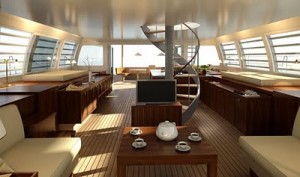
Catamarans or cats as they are called in marine lingo are type of water craft with twin hull structure and a mast at the center. Hulls are the water tight bodies of the boat below the deckhouse. The two hulls are joined by some structure with frames made of ‘akas’. The catamarans can be manual (sails) or machine powered (engine- diesel or wind power ).They are known for their speed and robustness on the flowing water. The catamarans were designed centuries back, yet the modern version consists of some unorthodox feature, not fully approved of by the traditional boat makers or catamaran makers. They were mainly used for races in the earlier times
. The word Catamaran is derived from Tamil word ‘Kattumaram’, which meant logs joined or tied together. The first lot of the Catamarans were made by fishermen in the Indian Ocean (Indonesian area primarily). Their version of the ancient catamarans was different from canoes, which consisted of a single hull. They used two pontoons strapped diagonally and held by one deck. They had great speed and easy usage for those times and were even used to guard the coastlines as defense vehicles. Today these boats are seen as recreational boats around the world. The recent version of this type is considered as the most powerful water vehicles among other types of sailing boats. A conventional boat has a single hull resulting in a large amount of water drag proving detrimental to the speed of the water craft. Boats as catamarans have two or even more hulls that are a bit higher in water, which results in less resistance from water which further increases speed.
Catamarans create a phenomenon called ‘planing’ that is created by v-shaped hulls while rowing. As their hulls are usually thinner and lighter than the single hulled boats, their hulls remain slightly under water when the boat is on its peak speed. The two hulls together provide a robust stability and thus eliminate the need for an additional force of current or ballast. They have a wider beam which makes them one of the most stable deigns of a water vehicle. Thus they are said to be more suited to the coastal regions because of the sheltered water helping them reach their maximum speeds.
- Features of a Catamaran
These are light in weight due to a hull section that is thin and the absence of keel counter weight. The wide beams provide better stability allowing carrying of more sail per unit of length. Better stability results in the boat staying erect in the wind and gaining more power. The most difficult thing about catamarans is handling during a turn, as these boats have the tendency to turn upside down if not reversed in exact time. This is so because these are lighter in weight. The person who is sailing has to lean out from the opposite hull so as to counterbalance the Catamaran while turning on a side. A straight path cannot be followed while steering, usually a zigzag way is followed.  Types of Catamarans:
Types of Catamarans:
Two main types of Catamarans exist which are: • Regular Catamaran; • Open catamaran.
These are further divided into: • Pontoon • Swaths  The engine powered catamarans are quite hefty and can gibe luxurious yachts and small cruises a run for its size .A new trend is evolving for using Catamarans as high speed ferries. There are fusions available since last decade, of yacht and Catamaran, a v. powerful water boat.
The engine powered catamarans are quite hefty and can gibe luxurious yachts and small cruises a run for its size .A new trend is evolving for using Catamarans as high speed ferries. There are fusions available since last decade, of yacht and Catamaran, a v. powerful water boat.





